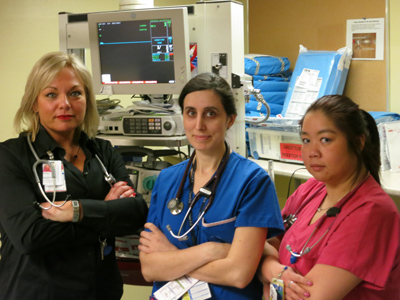
From left to right, emergency care staff Kathy Bates, Patient Care Coordinator, along with RNs Licinia Simoes and Chai Shi Yee (Photo: UHN)
As we look back on 2013, we celebrate the courage that lives at UHN with the 'Celebration of Courage' series. In this fourth part, we recognize honour the courage of emergency staff workers who battled the flu on the front lines.
Nurse manager Jill Smirnis remembers the surge of patients clearly.
They came in by cab and ambulance, lying on stretchers and in wheelchairs– coughing and sneezing, vomiting and suffering from diarrhea.
Flu season had hit.
"Families and patients were spilling out into the hallways, and patients were filling up every single bed in Emergency," Smirnis recalled. "Often it was standing room only."
Smirnis works in Toronto Western Hospital's emergency department. She and fellow Emergency staff members at TWH and Toronto General Hospital were on the front lines of this year's flu and stomach infection season gone wild.
'Like the Don Valley Parkway'
"It was like the Don Valley Parkway at 4 p.m. on a Friday, with four lanes reduced to one," said Kathy Bates, Emergency Patient Care Co-ordinator at the Toronto Western. "It was a pressure cooker, with constant monitoring to make sure that every patient remained stable."
During this time at TWH alone, staff saw an increased number of patients– up to 184 a day— compared to around 160 patients a day during non-flu season. At one point, three patients were intubated simultaneously with mechanical breathing machines, waiting for ICU admissions.
Adding to the workload were the extra precautions that need to be taken during flu season. Staff are required to thoroughly examine anyone who comes through the door with flu-like symptoms..
Extra isolation rooms
It can often mean creating extra isolation rooms with posted signs, leaving carts with supplies outside the room, and ensuring that everyone going in takes extra precautions such as donning gowns, gloves, masks and goggles.
All this, on top of what Emergency sees in a typical 12-hour shift in the winter: patients with heart attacks, those with end-stage diseases who are dying, patients who have slept out in the cold and need to be wrapped in a "bear hugger" or warming blanket, those with broken or fractured limbs, some who have ingested too much alcohol or drugs, and those who are suffering from the flu and have nowhere to go since physicians' offices are closed over the holidays.
But Emergency staff, most of whom worked many hours without breaks throughout the exceptionally busy season, came together, keeping an eye out for each other and each other's patients.
"Are you ok? What can I do for you?" or "Extra hands here!" rang back and forth throughout the department.
One patient care assistant decorated the department with a holiday motif, boxes for the food bank were put out, and potluck suppers were organized to get into the holiday spirit.
"We don't have set hours. And we never close our doors, no matter how many patients we have," said Kathy. "You really have to love the chaos, the challenge, the unknown."
RELATED
